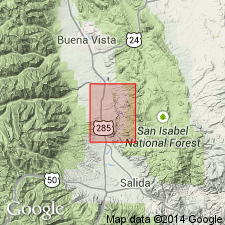
- Usage in publication:
-
- Browns Canyon Formation*
- Modifications:
-
- Named
- Dominant lithology:
-
- Siltstone
- Claystone
- AAPG geologic province:
-
- Eagle basin
Summary:
Named for Browns Canyon, Poncha Springs NE quad, Chaffee Co., CO. Type locality is in secs 22, 27, and 28, T51N, R8E, in Eagle basin. Consists of seven [SIX] small masses at type locality. Composed of gray and brown to yellow-brown, locally finely ripple marked, tuffaceous siltstone interbedded with calcareous siltstone, sandy siltstone, ferruginous claystone, and lithic and crystal tuff. Rocks are moderately well consolidated, locally dense and flinty, and have a conchoidal fracture. A basal conglomeratic arkose contains angular to subrounded fragments mostly of underlying Precambrian quartz monzonite. Ranges from a few ft to about 50 ft thick. Mapped as a separate unit from Dry Union because siltstone is more consolidated, indurated, folded and faulted, and has a different lithology (locally mineralized with fluorite); the siltstone dips steeply on upthrown side of a normal fault whereas nearly horizontal Dry Union forms hanging wall. Fossils are Miocene plants rather than Pliocene vertebrates as in Dry Union.
Source: GNU records (USGS DDS-6; Denver GNULEX).
For more information, please contact Nancy Stamm, Geologic Names Committee Secretary.
Asterisk (*) indicates published by U.S. Geological Survey authors.
"No current usage" (†) implies that a name has been abandoned or has fallen into disuse. Former usage and, if known, replacement name given in parentheses ( ).
Slash (/) indicates name conflicts with nomenclatural guidelines (CSN, 1933; ACSN, 1961, 1970; NACSN, 1983, 2005, 2021). May be explained within brackets ([ ]).

